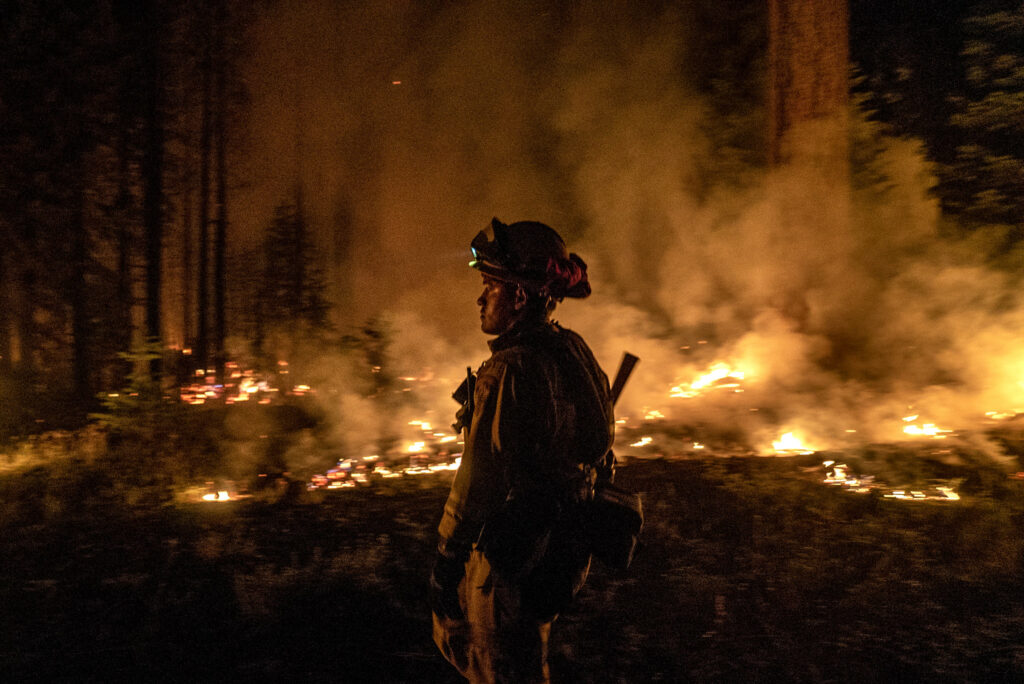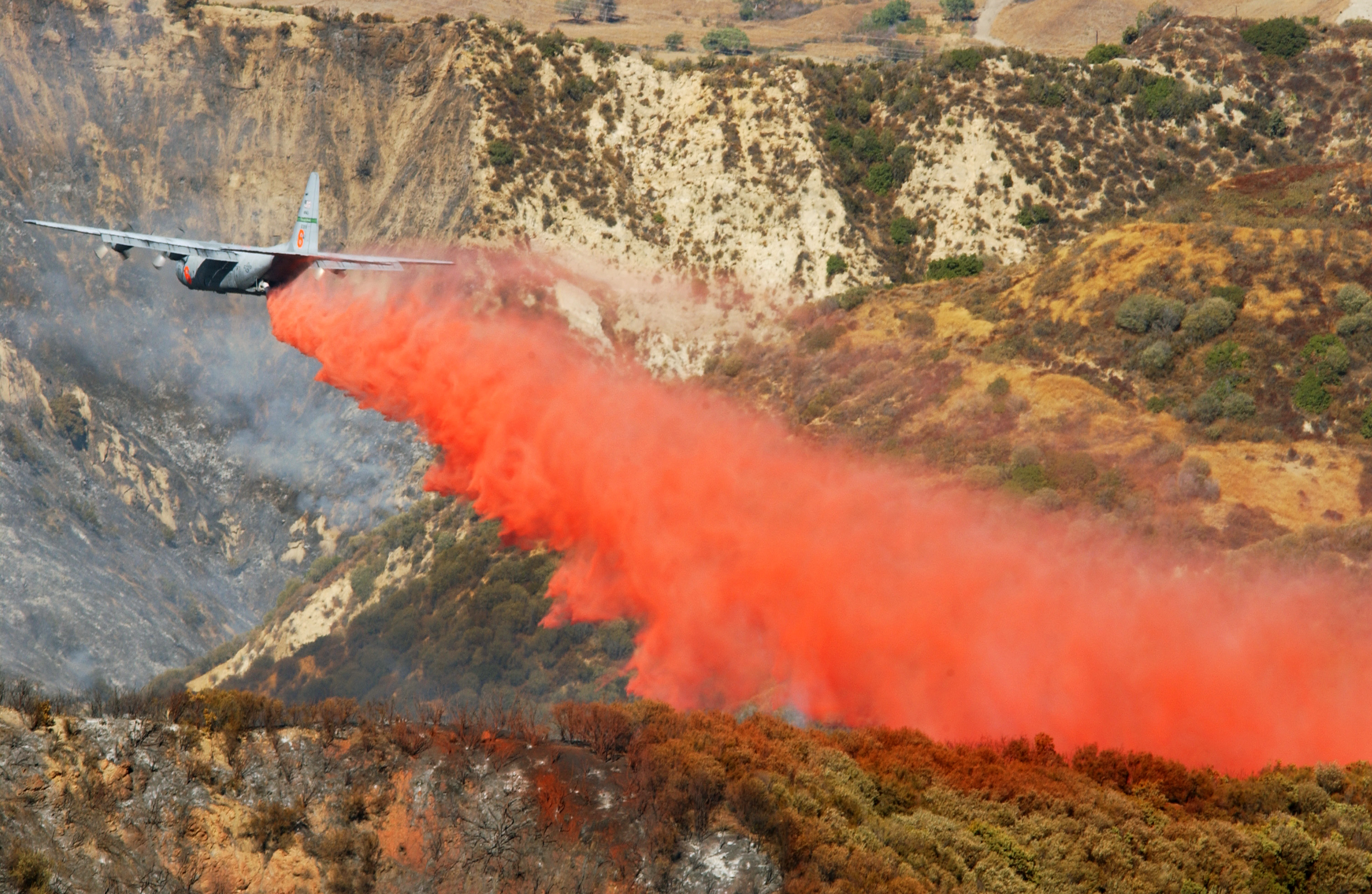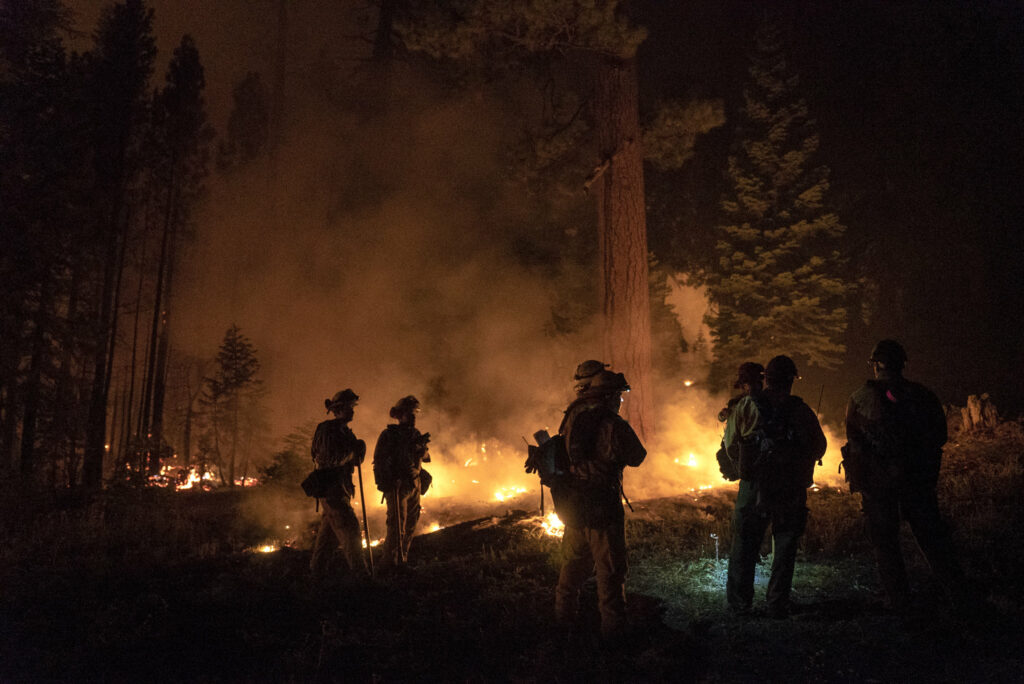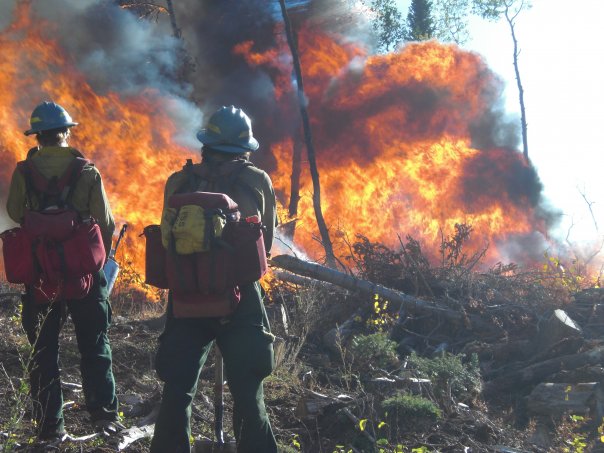Low Pay, Massive Fires: The Life of a CA Wilderness Firefighter
We now live in a state which has a high risk of fires for nearly half the year (or more). I got curious and ended up sitting down to talk with a California Forest Service Firefighter who has worked all over Idaho, California, and pretty much all of the western United States for the last 16 years.
Our firefighting source wanted to remain anonymous so that we could speak more freely about certain aspects of the job – specifically burnout and lower pay as compared to other organizations.

Christian Ramos, Cal State firefighter, works during a night operation to push back a fireline at the Donnell Fire, Stanislaus National Forest, California. (Forest Service photo by Cecilio Ricardo)
What’s the basic process behind fighting a fire with a helicopter & crew?
Our source’s specific expertise is Firefighting Aviation. He works with those massive helicopters that dump water and sometimes fire retardant onto a fire as it’s happening. I was told that helicopters are typically the first line of defense against forest fire, especially if the local crew can’t get there in time or it’s in a place that is hard to reach. The pilot will drop off the crews of 3-10 people (depending on the size of the aircraft) along with their gear. Firefighters fight the fire on land with tools that help extinguish the fire.
Aircraft put on the bucket, and assists them from the air using water from a nearby source. When needed, a plane (and sometimes a helicopter) will drop red chalk-like material over a fire to help extinguish it. The material used by The Forest Service is called Phos-check. Air tankers will typically be the ones that use fire retardant but you may see helicopters use it for extended incidents.
Phos-check is the most common retardant in the world, actually. It’s made of a bunch of materials such as phosphates and sulfate salts which act as the fire retardant itself. To help it stay put on the ground, you can find guar gum and clay in it as well to thicken the substance. Beyond helping to put out a fire, Phos-check acts as a fertilizer once the danger has passed. However, according to Wikipedia, it also has been linked to potentially causing algae blooms in bodies of water downstream from a fire as well as has been linked to the growth of invasive plant species.
Local Journalism for Working stiffs
We write for the poets, busboys, and bartenders. We cover workers, not ‘tech’, not the shiny ‘forbes 100 bullshit’. We write about the business on your corner and the beer in your hand. Join the Bay's best newsletter.
I found it interesting to learn that the Forest Service doesn’t own the helicopters which fight fires. These are private contracts. The pilot isn’t a Forest Service employee. So, when it comes to guiding the helicopter to the area where the fire is and knowing where to drop a crew, there will regularly be a manager on board. Our source was that manager for many years. He would sit up with the pilot and tell them what needs to happen next.

Fire retardant being dumped on an active fire – photo from Wikipedia
What’s it like managing a crew during a fire?
He has worked his way up to being a Forestry Technician managing a large crew. Currently, he is a Helicopter Manager with the helicopter pilots coordinating their contracts with the Forest Service and making sure they maintain compliance with the contract and safety standards. He doesn’t have to fly out of a helicopter as he’s done in the more recent past but he’s still close to the fire and has to be on the scene directing and coordinating the fire efforts.
Looking back at when he was managing a large crew of firefighters, there could be a group of 15 to manage during a fire. Often, he would have rookie firefighters who were just learning how to use the proper tools for the job. Once on the ground, he would have to keep an eye out to make sure everyone was using tools properly and pitching in while he was also fighting the fire himself. I can’t even imagine how stressful that would be.
He recalled, “sometimes you’d look over and someone was just sorta standing there or using the tool improperly and you’d have to encourage them to get back to work. My management style is sorta sarcastic so I’d say stuff to them like ‘do you swing your purse around like that?’ and we’d laugh and get back to work.”
You have to have some humor to cut through some of the stress and tension of the job. Especially if you’re working the long hours they have to work. Typically, a Forest Service firefighter will work a 12-16 hour shift, sleep and then go back into the fire. You work 2 weeks at a time while fighting a fire and then only have a couple of days off before you have to be back in the thick of things.
How much can you expect to get paid as a Forest Service Fire Fighter?
I always thought this type of job pays well. Compared to some jobs, maybe so. When I asked my source, he told me that it’s basically impossible to make a living wage unless you work massive overtime. In order for him to make enough to support his family, he has to work 1K hours of overtime. That’s not sustainable. I did some of my own research and it looks as if you start a job like this at around $12 an hour. The average yearly salary is around 57K, according to Glassdoor. Of course, it does vary depending on what state you work in and whether they have additional pay tacked on for things like hazard pay which is only given in some states.
A Forest Service firefighter in Washington talked about the need to rely on overtime when speaking to The Washington Post, “We would not be able to afford our mortgage or my medical bills,” she added. “Our financial well-being is directly tied to how severe the fire season is. The busier the season, the more money he makes … While the overtime keeps us afloat, the downside is all the family time and mental and physical health that must be sacrificed.”
Firefighters rely on overtime each summer and they expect it but they also don’t have any choice and have to take the overtime when it comes. Our firefighting source told me that you’re basically “volun-told to go fight a fire”. Meaning that you don’t get to decide when you take on overtime or not because you are assigned to fires as needed. Your summer is when you will make the most of your overtime pay. However, what used to be a summer seasonal job is now a full-time year-round job.

Forest Service and Cal State firefighters work together in a night operation to push back a fire line at the Donnell Fire, Stanislaus National Forest, California. (Forest Service photo by Cecilio Ricardo)
What are the biggest issues a Forest Service Firefighter faces?
Let’s acknowledge that fighting the actual fires is likely the hardest part. However, other things impact the job as well. Recruitment is a hot topic right now and is being talked about more and more. “People are increasingly burnt out,” said Luke Mayfield, vice president of the Grassroots Wildland Firefighters and former U.S. Forest Service firefighter.
Our source opened up about what he found to be some other big issues. He noted that the pay is one of the biggest issues due to having to do overtime in order to make a living wage as well as the fact that some other agencies pay better than the federal government & often people will come train with him and move on to higher paying jobs. Sometimes, he said, you end up training folks to do the job and then see them leave for another agency soon after. I learned that, last Spring, during a Senate Appropriations Interior subcommittee hearing, Forest Service Chief Randy Moore warned that staffing is “as low as 50 percent in some areas,” noting states such as California, Washington, and Oregon.
You end up losing good people due to other organizations having a better work/life balance, too. Many folks move on to organizations like Cal-Fire. Compared to the Forest Service workers pulling 16-hour days for 2 weeks straight, Cal-Fire has their workers on one day and the next, but paid straight through, 24 hours a day when on assignment.
According to The Washington Post federal firefighters are still waiting for a pay boost that was promised to them last year. This pay increase was meant to help retain and recruit more folks to fight fires. A temporary pay raise went into effect but this was only guaranteed through next October.
“All federal wildland fire agencies are experiencing some hiring, recruitment, and retention challenges in locations where state and private firefighter wages are out-competing federal firefighter wages, housing costs are not affordable, and positions are in remote locations, especially with our temporary (seasonal) firefighters,” the Forest Service said in a statement. “Maintaining our ability to hire and retain firefighters as we see the complexity of the firefighting environment grow exponentially is a challenge that we take seriously.”
What’s in a Forest Fighter’s red “go-bag”?
Each firefighter has a “red bag” that they bring with them as well as a fireline backpack. A wilderness firefighter’s red bag is essentially their version of a travel bag where they carry additional equipment necessary for longer assignments. This bag has to carry their camping supplies and clothes for the job and also their personal items for the week ahead.
So, what does a Forest Firefighter pack when they are away for up to two weeks at a time? I learned in my interview that it varies from person to person. You get one bag that you can take with you for your personal gear which is their red bag. Hilariously, he prioritizes underwear over anything else. “I pack lots of underwear. I can go days wearing the same clothes, even socks, but I gotta change my underwear every day.” Some of his peers will pack less underwear and need to have their morning coffee. But for our source, nothing makes you feel more human than a fresh pair of undies.
In addition to their red bag along with standard issue clothing, a wilderness firefighter would likely be carrying a fireline backpack which contains essential tools they need while fighting the fire on the ground. This bag would include such things as their Pulaski (a special tool made specifically for fighting fires), fire shelter, fire gloves, mask, at least four quarts of water in canteens, first aid kit, compass, high visibility flags, headlamp, and GPS. Depending on where the fire is, there may be additional equipment that is brought along, too.
Why keep working for the Forest Service as a Firefighter?
Our firefighting hero has a true love for the job. He also has loyalty and has put in a lot of time on the job. After 16 years, he’s only 11 years away from retirement. If he were to consider moving onto a new agency, he’d be 20+ years away from retirement. For him, the best thing he can do is to stay put.
Hopefully, laws will pass that make working such a hard job easier for folks wanting to pursue a career in this type of work & those already in it.
There seems to be hope on the horizon. According to one article, I read while researching this topic, “More money is coming to firefighters across the nation. The 2022 bi-partisan infrastructure bill gives $600 million to pay firefighters more.” But no one has seen any of this money yet and meanwhile “We are losing more than we are bringing on. And a lot of the folks we are losing are some of the best and the brightest,” said Luke Mayfield, vice president of the Grassroots Wildland Firefighters and former U.S. Forest Service firefighter.

Howdy! My name is Katy Atchison and I'm an Associate Editor for Broke-Ass Stuart.
I want to take the time to say thank you for supporting independent news media by reading BrokeAssstuart.com. Supporting independent news sources like Broke-Ass Stuart is vital to supporting our community because it amplifies the voices of a wide variety of diverse opinions. You also help support small businesses and local artists by sharing stories from Broke-Ass Stuart.
Because you're one of our supporters, I wanted to send over a pro-tip.
Our bi-weekly newsletter is a great way to get round ups of Broke-Ass Stuart stories, learn about new businesses in The Bay Area, find out about fun local events and be first in line for giveaways.
If you’d like to get our newsletter, signup right here, it takes 5 seconds.









